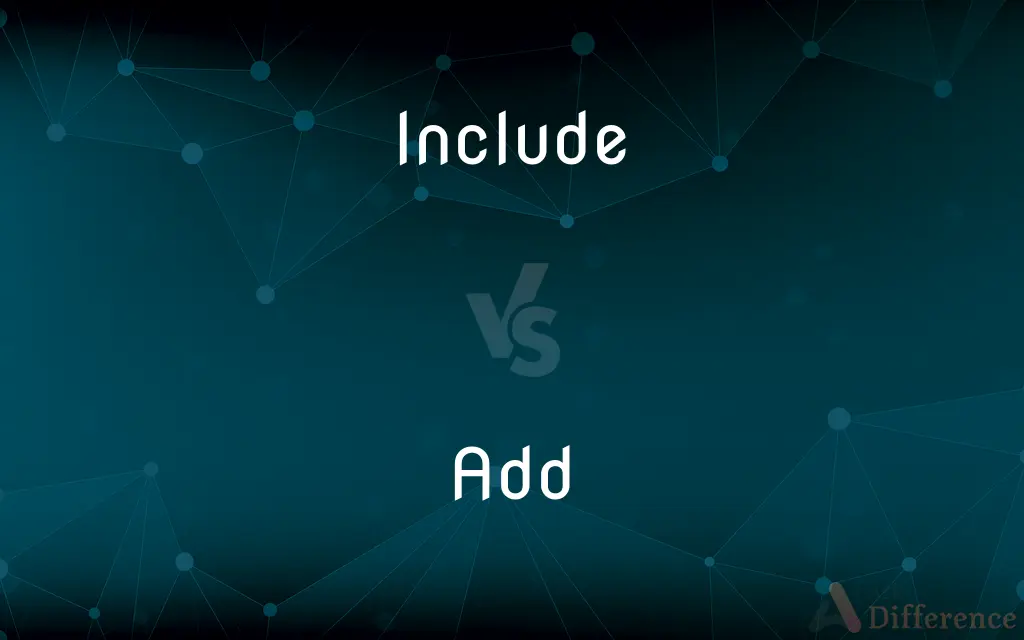Include vs. Add — What's the Difference?
By Tayyaba Rehman & Fiza Rafique — Updated on March 18, 2024
Include implies having something as a part or element of a larger whole, while add means to join or combine one thing with another to increase the amount, number, or extent.

Difference Between Include and Add
Table of Contents
ADVERTISEMENT
Key Differences
Include is used to express that something is a constituent part of a group, set, or whole. It conveys the idea that the item or element is already a part of something, without necessarily implying an action of insertion or addition. On the other hand, add suggests an action where one or more items are joined or combined with others, increasing the total number, quantity, or scope. Adding implies an active step taken to unite elements, such as adding sugar to a recipe, which increases the total number of ingredients.
When we say something is included, it highlights its presence as part of a larger entity or collection, emphasizing its belonging within a predefined set. In contrast, when we add something, it underscores the act of expansion or augmentation, reflecting a dynamic process of enhancement or growth. The distinction lies in inclusion being a state of being part of a set, whereas addition is the process of becoming part of that set.
The context in which include and add are used also differs. Include often appears in scenarios where the composition of a group or collection is described, focusing on the elements that comprise it. For example, a conference agenda might include several key topics, indicating these topics are encompassed within the agenda. Add, however, is frequently used in contexts requiring action, such as instructions or processes, highlighting the act of incorporation or expansion, like adding a topic to an existing conference agenda.
Both terms imply a sense of aggregation but from different perspectives. Including something means it is already counted within a collective, without the need for further action to make it part of the whole. Adding, conversely, is the action that causes the aggregation, changing the makeup of the whole by increasing its components.
Comparison Chart
Definition
To have as a part or element of a larger whole
To join or combine something with another to increase the amount, number, or extent
ADVERTISEMENT
Implication
Presence within a set or whole
Action of increasing or expanding
Context
Describing composition of groups or collections
Processes requiring incorporation or expansion
Focus
Emphasizing belonging within a predefined set
Highlighting the act of incorporation or enhancement
Action vs. State
State of being part of a set
Process of becoming part of a set
Compare with Definitions
Include
To contain as a part of a whole.
The course includes ten lessons on grammar.
Add
To contribute or enhance.
Adding a rug to the room will add warmth and style.
Include
To list as part of a group or category.
The menu includes a range of vegetarian options.
Add
To join or combine to increase size or number.
Add the tomatoes to the sauce and stir.
Include
To imply as part of something indirectly.
The job includes responsibilities such as managing schedules.
Add
To append or attach something new.
Add your signature at the bottom of the document.
Include
To encompass within a boundary or scope.
The study includes data from the past five years.
Add
To perform the mathematical operation of addition.
If you add 4 and 5, you get 9.
Include
To consider as part of something.
The team includes both experienced and novice players.
Add
To include extra elements or details.
You need to add more information to your report.
Include
Comprise or contain as part of a whole
Other changes included the abolition of the death penalty
The price includes dinner, bed, and breakfast
Add
Join (something) to something else so as to increase the size, number, or amount
A new wing was added to the building
Some box offices now add on a convenience charge
Include
Make part of a whole or set
We have included some hints for beginners in this section
Add
Put together (two or more numbers or amounts) to calculate their total value
Add the two numbers together
They added all the figures up
Include
To contain or take in as a part, element, or member.
Add
Say as a further remark
We would like to add our congratulations
‘I hope we haven't been too much trouble,’ she added politely
Include
To consider as part of or allow into a group or class
Thanked the host for including us.
Add
To join or combine (numbers) through addition
If you add 5 and 10 and 17, the result is 32. If you add 6 to 8, you get 14.
Include
To bring into a group, class, set, or total as a (new) part or member.
I will purchase the vacation package if you will include car rental.
Add
To join or unite so as to increase in size, quantity, quality, or scope
Added 12 inches to the deck.
Flowers that added beauty to the dinner table.
Include
To consider as part of something; to comprehend.
The vacation package includes car rental.
Does this volume of Shakespeare include his sonnets?
I was included in the invitation to the family gathering.
Up to and including page twenty-five
Add
To say or write further.
Include
(obsolete) To enclose, confine.
Add
To find a sum in arithmetic.
Include
(obsolete) To conclude; to terminate.
Add
To constitute an addition
An exploit that will add to her reputation.
Include
(programming) To use a directive that allows the use of source code from another file.
You have to include the strings library to use this function.
Add
To create or make an addition
Gradually added to my meager savings.
Include
(programming) A piece of source code or other content that is dynamically retrieved for inclusion in another item.
Add
(transitive) To join or unite (e.g. one thing to another, or as several particulars) so as to increase the number, augment the quantity, or enlarge the magnitude, or so as to form into one aggregate.
Include
To confine within; to hold; to contain; to shut up; to inclose; as, the shell of a nut includes the kernel; a pearl is included in a shell.
Add
To sum up; to put together mentally; to add up.
To add numbers
Include
To comprehend or comprise, as a genus the species, the whole a part, an argument or reason the inference; to contain; to embrace; as, this volume of Shakespeare includes his sonnets; he was included in the invitation to the family; to and including page twenty-five.
The whole included race, his purposed prey.
The loss of such a lord includes all harm.
Add
(transitive) To combine elements of (something) into one quantity.
To add a column of numbers
Include
To conclude; to end; to terminate.
Come, let us go; we will include all jarsWith triumphs, mirth, and rare solemnity.
Add
(transitive) To give by way of increased possession (to someone); to bestow (on).
Include
Have as a part, be made up out of;
The list includes the names of many famous writers
Add
(transitive) To append (e.g. a statement); to say further information; to add on.
Include
Consider as part of something;
I include you in the list of culprits
Add
(intransitive) To make an addition; to augment; to increase; to add on.
It adds to our anxiety.
Include
Add as part of something else; put in as part of a set, group, or category;
We must include this chemical element in the group
Add
To perform the arithmetical operation of addition.
He adds rapidly.
Include
Allow participation in or the right to be part of; permit to exercise the rights, functions, and responsibilities of;
Admit someone to the profession
She was admitted to the New Jersey Bar
Add
To summon minions or reinforcements.
Typically, a hostile mob will add whenever it's within the aggro radius of a player.
Add
(radio) The addition of a song to a station's playlist.
Add
(computer science) An act or instance of adding.
Add
(video games) An additional enemy that joins a fight after the primary target.
When the player has fought the boss for one minute, two adds will arrive from the back and must be dealt with.
Add
To give by way of increased possession (to any one); to bestow (on).
The Lord shall add to me another son.
Add
To join or unite, as one thing to another, or as several particulars, so as to increase the number, augment the quantity, enlarge the magnitude, or so as to form into one aggregate. Hence: To sum up; to put together mentally; as, to add numbers; to add up a column.
Back to thy punishment,False fugitive, and to thy speed add wings.
As easily as he can add together the ideas of two days or two years.
Add
To append, as a statement; to say further.
He added that he would willingly consent to the entire abolition of the tax.
Add
To make an addition. To add to, to augment; to increase; as, it adds to our anxiety.
Add
To perform the arithmetical operation of addition; as, he adds rapidly.
Add
A condition (mostly in boys) characterized by behavioral and learning disorders
Add
Make an addition (to); join or combine or unite with others; increase the quality, quantity, zise or scope of;
We added two students to that dorm room
She added a personal note to her letter
Add insult to injury
Add some extra plates to the dinner table
Add
State or say further;
`It doesn't matter,' he supplied
Add
Bestow a quality on;
Her presence lends a certain cachet to the company
The music added a lot to the play
She brings a special atmosphere to our meetings
This adds a light note to the program
Add
Make an addition by combining numbers;
Add 27 and 49, please!
Add
Determine the sum of;
Add all the people in this town to those of the neighboring town
Add
Constitute an addition;
This paper will add to her reputation
Common Curiosities
How do "include" and "add" differ in terms of action?
"Include" suggests a state of being part of a set without needing further action, while "add" refers to the act of joining or combining, which changes the composition of the whole.
What does add mean in a context?
In a context, add means to join or combine one thing with another, thereby increasing the total amount, number, or scope.
Can "include" and "add" be used interchangeably?
While they can sometimes be used in similar contexts, they are not interchangeable as "include" emphasizes belonging within a set, whereas "add" emphasizes the action of increasing or expanding.
What does it mean to include something?
To include something means to have it as a part of a larger whole or set, emphasizing its presence within a predefined boundary.
When is it more appropriate to use "add" instead of "include"?
"Add" is more appropriate in scenarios requiring action, such as when you are increasing the quantity, number, or scope of something.
Is "add" always related to physical items?
No, "add" can refer to physical items, concepts, information, or abstract elements being joined or combined with others.
In what context would you use "include" over "add"?
You would use "include" when describing the composition of a group, set, or collection to emphasize that something is already a part of it.
How do usage of "include" and "add" affect the clarity of instructions?
Using "include" clarifies what is already part of a set, while "add" provides clear action steps for expanding or enhancing the set, both contributing to clearer instructions.
Does "include" imply membership within a group?
Yes, "include" implies that something is a member of a group or part of a larger whole.
Can "include" suggest indirect implications?
Yes, "include" can also suggest indirect implications or encompass elements that are not explicitly stated but are understood to be part of something.
Are there scenarios where "add" does not imply an increase in number?
While "add" typically implies an increase, it can also refer to the enhancement of quality or functionality without necessarily increasing quantity.
Can something be added and included at the same time?
Yes, something can be added to a set or collection and then be considered as included within it once the addition is complete.
What is the significance of using "include" in instructions?
Using "include" in instructions signifies that certain elements or steps are essential parts of the process or list being described.
How does "add" function in mathematical contexts?
In mathematical contexts, "add" refers to the operation of addition, calculating the sum of two or more numbers.
What role does context play in determining the use of "include" vs. "add"?
Context is crucial; "include" is used to denote membership or presence within a whole, while "add" indicates the action of combining or increasing, depending on the nature of the discussion or instruction.
Share Your Discovery

Previous Comparison
Paradox vs. Pun
Next Comparison
Jumpy vs. NervousAuthor Spotlight
Written by
Tayyaba RehmanTayyaba Rehman is a distinguished writer, currently serving as a primary contributor to askdifference.com. As a researcher in semantics and etymology, Tayyaba's passion for the complexity of languages and their distinctions has found a perfect home on the platform. Tayyaba delves into the intricacies of language, distinguishing between commonly confused words and phrases, thereby providing clarity for readers worldwide.
Co-written by
Fiza RafiqueFiza Rafique is a skilled content writer at AskDifference.com, where she meticulously refines and enhances written pieces. Drawing from her vast editorial expertise, Fiza ensures clarity, accuracy, and precision in every article. Passionate about language, she continually seeks to elevate the quality of content for readers worldwide.
















































